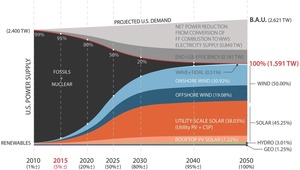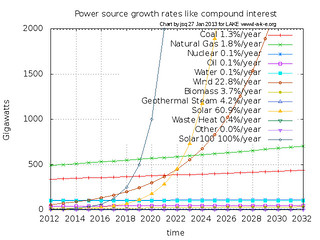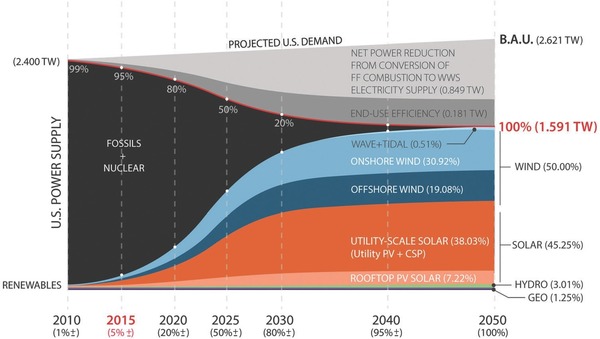Here’s how to convert everything from air conditioners to trucks
 from fossil fuels to 100% renewable sun, wind, and water power by 2050,
generating more jobs than would be lost from dirty energy,
stopping tens of thousands of premature deaths from pollution,
saving about 4% of U.S. GDP, plus saving $3.3 trillion worldwide
climate change costs.
from fossil fuels to 100% renewable sun, wind, and water power by 2050,
generating more jobs than would be lost from dirty energy,
stopping tens of thousands of premature deaths from pollution,
saving about 4% of U.S. GDP, plus saving $3.3 trillion worldwide
climate change costs.
That’s 100% as in no coal, oil, natural gas, nuclear, or biomass, just clean solar, wind, and water power: 90% by 2035, 80% by 2030, and 25% by 2025. No new technology required: just existing solar, wind, and water power production with batteries and hydrogen fuel cells for transportation, plus huge efficiency savings both from using electricity directly and through other well-known techniques.
A cleaner, healthier world is within our reach. And when even the country’s most corrupt legislature can unanimously pass and the Georgia governor who took campaign funds from six pipeline companies can sign a solar financing law, while Georgia has already become the fastest-growing solar market in the country, renewable energy is producing the political will to get this done.
Stanford Report, 8 June 2015, Stanford engineers develop state-by-state plan to convert U.S. to 100% clean, renewable energy by 2050: Mark Z. Jacobson and colleagues show that it’s technically possible for each state to replace fossil fuel energy with entirely clean, renewable energy. This figure comes from the referenced paper:
 Up through 2023 Jacobson’s graph is quite similar for solar
and wind power to the one I drew two years ago, with
those two power sources rapidly overtaking everything else, and
solar overtaking wind.
Up through 2023 Jacobson’s graph is quite similar for solar
and wind power to the one I drew two years ago, with
those two power sources rapidly overtaking everything else, and
solar overtaking wind.
Jacobson shows something I didn’t: the rapid collapse of fossil fuel and nuclear power supplies, as solar and wind (and some water) displace thermal power. With banks bailing out of coal and investors saying “short North American frackers”, while everybody from Harvard students to the Pope says we have to get off of fossil fuels, nobody has to be a prophet to see the carbon bubble is going to pop soon.
About 2025 Jacobson shows solar and wind slowing growth, apparently because dirty fuels are crashing so fast that along with efficiency improvements there’s not as much need to ramp up as fast.
While I merely predicted solar would overtake every other power source within ten years (by 2023), Jacobson takes into account transportation and everything else as well as traditional electricity uses. The complete conversion naturally takes longer than ten years, although by 2023 we’ll see about a quarter of U.S. power from clean sources already. With Tesla and numerous others announcing batteries for everything from electric vehicles to house and utility storage, Jacobson’s predictions may well be conservative.
But that’s the beauty of what he’s done. He’s demonstrated we can do this, and we can do it quickly, without any magical new inventions. Nothing is required beyond existing technology.
So let’s get on with at least slowing climate change while building a cleaner, healthier world, with more jobs and profit.
-jsq
Short Link:
